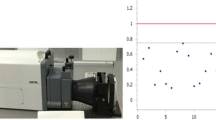Abstract
Fast adaptive optical system usually used in atmosphere tasks—for wavefront correction of the laser beam passed through a turbulent atmosphere. As a rule, the frequency of waveform distortions is about 100 Hz (roughly). Consequently, the frequency of discreet system should be about 1500 frames per second. Achieving such performance is possible by FPGA using for full closed-loop cycle: image receiving from wavefront sensor, voltages array for deformable mirror calculation the and provision fast applying these voltages to deformable mirror. Main aspects of FPGA using to minimize the whole cycle of adaptive optical system are considered.
The study was carried out with a grant from the Russian Science Foundation (project No. 19-19-00706).
Access provided by Autonomous University of Puebla. Download conference paper PDF
Similar content being viewed by others
Keywords
1 Introduction
When a laser beam passes through the Earth’s atmosphere, its wavefront is distorted due to the action of turbulence. This leads to decrease the parameters of the radiation reaching the target. As a rule, this is a decrease in the fraction of the useful signal power. This problem is considered, for example, in [1]. To eliminate the negative effects of turbulence we propose to use the closed-loop adaptive optical system which attend to correct the laser wavefront by deformable mirror [2].
2 System Requirements
The main value that describes the state of the atmosphere is an atmosphere refractive index function [3]. Typical refractive index function for horizontal path is within \(C_{n}^{2} = \left( {10^{ - 13} \div 10^{ - 17} } \right) \left[ {m^{{ - \frac{2}{3}}} } \right]\), where 10−17 characterizes weak turbulence atmosphere; 10−13 corresponds to a stormy atmosphere.
To assess the speed of the adaptive optical system which is designed to correct for the wavefront of laser radiation propagating along a horizontal path, the following formulas based on Kolmogorov theory were used.
Fried’s coherence radius:
where L is the horizontal path distance, k is the wavenumber.
Greenwood frequency:
where V is a wind velocity; the typical number of which is within the range of 0.3 ÷ 25 m/s.
So, for the most frequent cases Fried coherence radius is within 10 mm ÷ 2.5 m and Greenwood frequency is within 10 ÷ 200 Hz. These values are in so-called sine terms. For the conversion to the discrete frames per second (fps) terms it is need to multiply this sine frequency by 10. Thus, to correct for the wavefront aberrations of the laser beam passing through the turbulence atmosphere, it is need to construct a closed-loop adaptive optical system with frame rate up to 2000 fps.
3 Main Algorithm
One of the main advantages of the FPGA is that it can perform parallel computing. In order to minimize the processing time of the information coming from the wavefront sensor, it is necessary to carry out processing in parallel with the receipt of data. As a wavefront sensor, a Shack-Hartman sensor is used as the one with the highest speed. This sensor consists of a high-speed camera and a microlens raster (lenslet). The basic idea of the processing algorithm is to carry out all the necessary calculations in parallel with receiving information from the camera. FPGA can process the part of full WFS image already received from the camera while the camera continues to transmit the rest of the image to the framegrabber. After the FPGA has received several lines containing images of the first row of focal points, the FPGA calculates the coordinates of the focal spot centers, calculates the shifts of these focal spots regarding reference and fills appropriate part of the voltages vector computation matrix. When the second image portion is received, the coordinates for the second row of the focal points are calculated. And so on. Thus, after the final portion of the image has arrived, the coordinates of all the focal points are computed and vector of voltages is calculated. Accordingly, the time diagram looks like shown on Fig. 16.1. This technique allows to significantly increase the frequency of the whole adaptive optical system and closely approach the frequency of the system to the frequency of the camera.
4 Results
The setup (Fig. 16.2) was assembled in the laboratory where experiments were carried out to correct the wavefront of laser radiation Wave front distortions were set using a turbulence generator, whose frequency ranged from 10 to 100 Hz (in Sinus terms).
As a result of the system operation, an improvement in the intensity distribution in the far zone (Fig. 16.3) was observed, while the frequency of the system operation is up to 1500 Hz.
References
M. Vorontsov, T. Weyrauch, G. Carhart, L. Beresnev, Adaptive optics for free space laser communications, in Lasers, Sources and Related Photonic Devices, OSA Technical Digest Series (CD), LSMA1 (2010)
A.L. Rukosuev, A.V. Kudryashov, A.N. Lylova, V.V. Samarkin, YuV Sheldakova, Adaptive optical system for real-time wavefront correction. Atmos. Oceanic Opt. 28(2), 189–195 (2015)
L.C. Andrews, R.L. Phillips, Laser beam propagation through random media, 2nd edn. (SPIE Press, Bellingham, WA, 2005)
A. Kudryashov, A. Lylova, V. Samarkin, J. Sheldakova, A. Alexandrov, Fast adaptive optical system for the high-power laser beam correction in atmosphere. Proc. SPIE 10410, 104100L (2017)
Author information
Authors and Affiliations
Corresponding author
Editor information
Editors and Affiliations
Rights and permissions
Copyright information
© 2021 The Author(s), under exclusive license to Springer Nature Singapore Pte Ltd.
About this paper
Cite this paper
Galaktionov, I.V., Kudryashov, A.V., Nikitin, A.N., Rukosuev, A.L., Samarkin, V.V., Sheldakova, Y.V. (2021). Features of FPGA Using in a Fast Adaptive Optical System. In: Singh, K., Gupta, A.K., Khare, S., Dixit, N., Pant, K. (eds) ICOL-2019. Springer Proceedings in Physics, vol 258. Springer, Singapore. https://doi.org/10.1007/978-981-15-9259-1_16
Download citation
DOI: https://doi.org/10.1007/978-981-15-9259-1_16
Published:
Publisher Name: Springer, Singapore
Print ISBN: 978-981-15-9258-4
Online ISBN: 978-981-15-9259-1
eBook Packages: Physics and AstronomyPhysics and Astronomy (R0)







